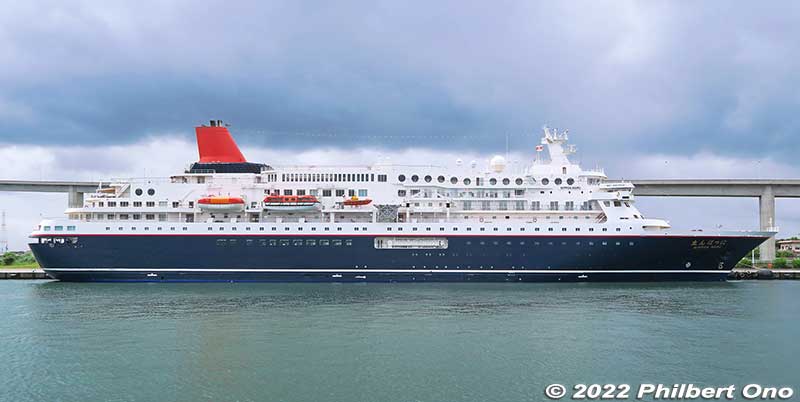
by Philbert Ono, Updated: June 6, 2023
Distinctive look, famous name, and food.
Built in 1990, Nippon Maru (にっぽん丸) is the smallest Japanese luxury cruise ship, but with the most distinctive paint job. Navy blue (almost black) hull with a red pinstripe, white top, and red funnel. Love it. It’s a classic cruise ship look. Looks much better than when the hull was originally all white (until 2009). It still looks like a ship, not a floating hotel.
This Nippon Maru cruise ship is not to be confused with the world-famous Nippon Maru (日本丸) sailing ship first built in 1930 as a Japanese training ship. It’s now a museum ship in Yokohama near Landmark Tower. There’s also a successor Nippon Maru sailing ship launched in 1984 and still training Japanese saliors.
So there are currently three well-known Japanese ships named “Nippon Maru.” To avoid confusion with the sailing ships, the Nippon Maru cruise ship has “Nippon” in hiragana (にっぽん丸) instead of kanji characters in its name. (Read more about the name below.)
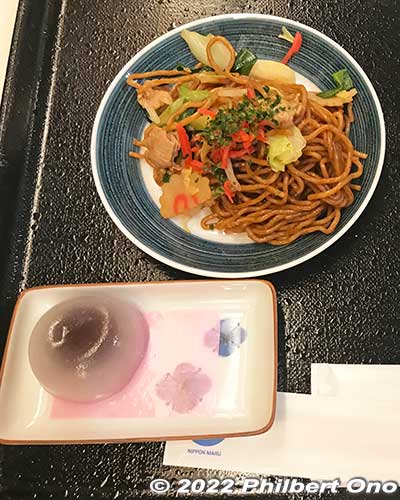
Famous for food
Cruise ship Nippon Maru prides itself on its cuisine. Their tagline is “Shoku no Nippon Maru” (食のにっぽん丸) or “Nippon Maru is for the food.” Especially Japanese cuisine or a fusion of Japanese and Western cuisine.
Another buzzword is bishoku (美食) or “beautiful and delicious food.” The food is also a work of art. A feast for both the eyes and palate. Nippon Maru may be more of a gourmet restaurant ship than anything else.
The food includes local ingredients from ports of call and seasonal dishes. The ship has two main dining rooms with large windows, a tea lounge overlooking the bow, sushi bar, bars, and poolside Lido Terrace. (Food photos here.)
One favorite and famous onboard treat is Godiva’s Chocolixir chocolate drink (ショコリキサー) at the poolside Lido Terrace. It’s a slightly slushy, semi-frozen drink blended with fine bits of chocolate and topped with whipped cream. Very popular among passengers since it’s free and all you can drink. You can also order free hot dogs and mini hamburgers to go with your Chocolixir. Chocolixir is also available at most Godiva shops on land for ¥650.
The ship’s lounges, bars, Lido Terrace, and other spots to hang out are never full of people. It’s a quiet, laid-back ship favored by elderly Japanese couples, retirees, and a few honeymooners.
Guests staying in the expensive suites have free Wi-Fi/Internet connection in their cabins and public spaces on the ship. However, watching videos, streaming programs, and video chatting (Skype, Zoom, etc.) are not allowed. (Cabin photos here.)
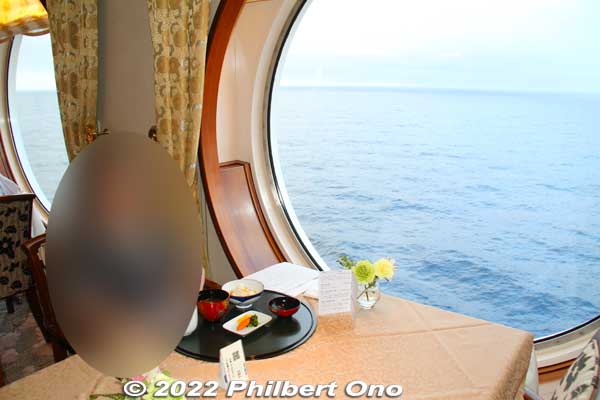
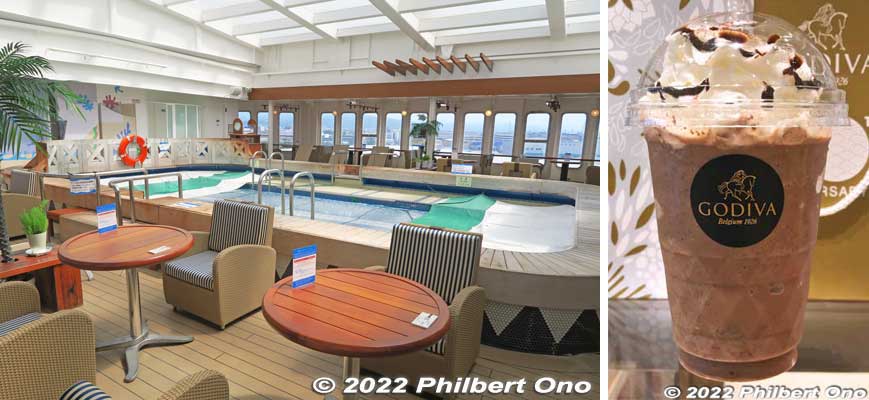
Internationally known
Although Nippon Maru mainly caters to Japanese customers, the ship is well known around the world among former participants of the annual Ship for World Youth (世界青年の船) charter cruise held since 1988 and the annual Ship for Southeast Asian and Japanese Youth Program (東南アジア青年の船) charter cruise since 1974.
Both cruise programs, sponsored by the Japanese government’s Cabinet Office, have used Nippon Maru in recent years for international and cultural exchanges between 200 and 300 young Japanese and foreigners (age 18 to 30). They cruise to overseas ports for over a month. Even Crown Prince Akishino once participated while he was a young bachelor. During the pandemic, however, the cruises have been suspended since 2020. Some program activities went online instead.
Although Nippon Maru is proud of its record in promoting international exchange and cultures, almost all its normal cruises remain almost exclusively for Japanese like the other two Japanese cruise ships (Asuka II and Pacific Venus).
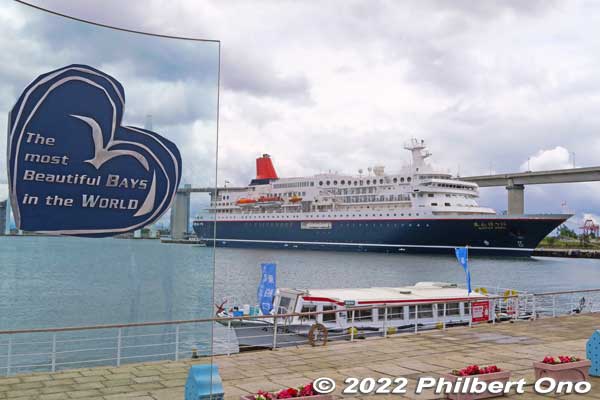

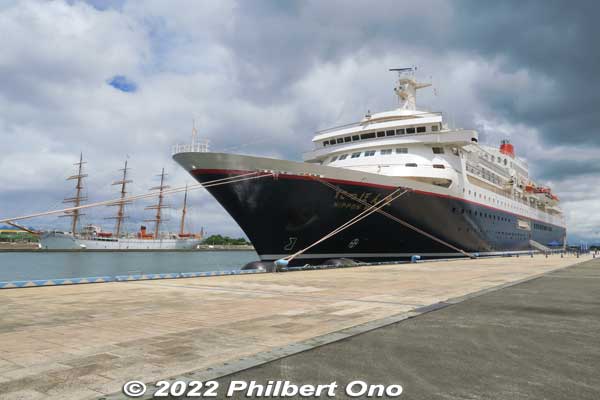

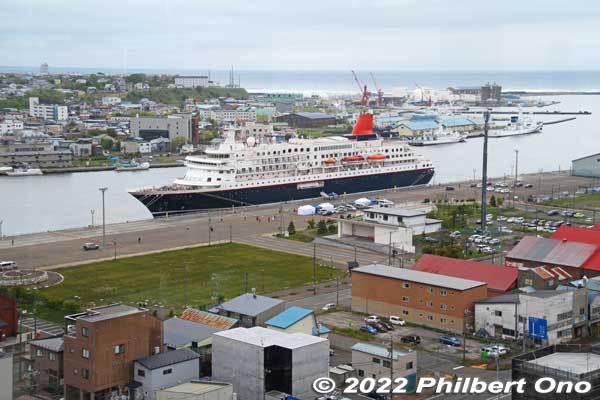
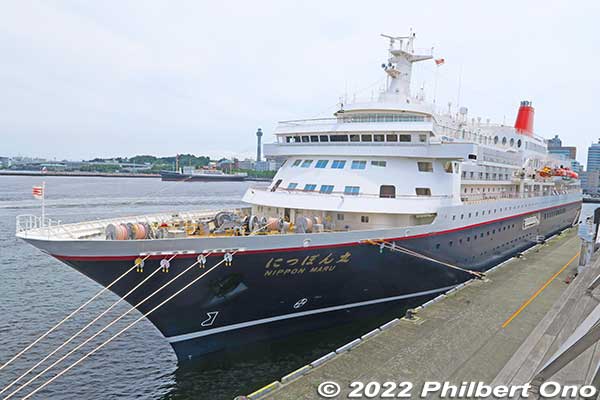

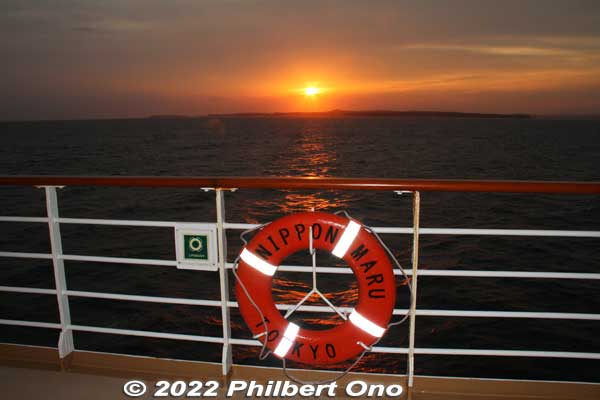

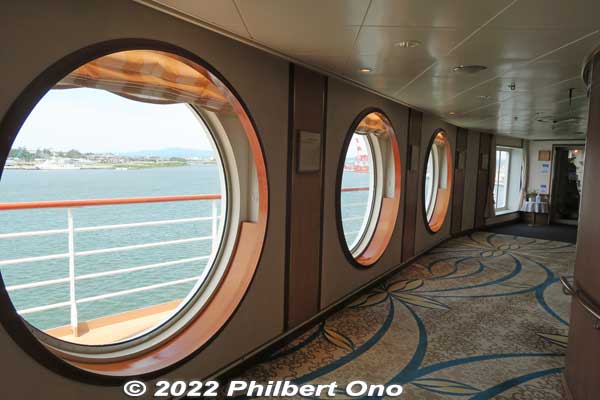

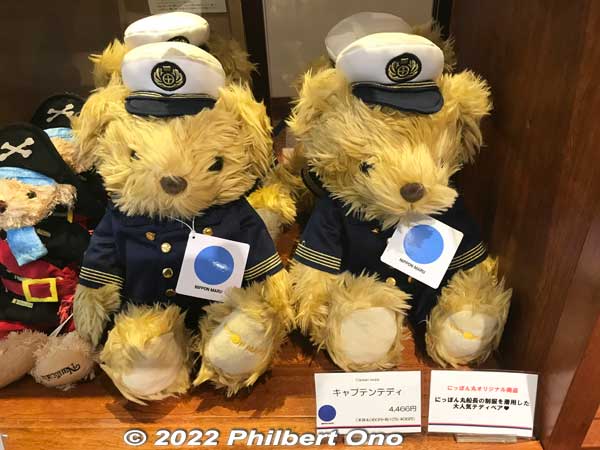


Nippon Maru: Pros
・Smallest cruise ship, easiest to get around.
・No crowds on board.
・Can dock at smaller ports.
・Reputation for fine dining, especially Japanese cuisine.
・Free Godiva Chocolixer chocolate drink.
Cons
・Few cabins have a balcony.
・Not geared for kids.
・Fitness gym is small (only 5 people).
・Ship is over 30 years old.
・Not international (passengers almost exclusively Japanese).
・No website in English.
Mitsui O.S.K. and Nippon Maru history
Nippon Maru is owned and operated by Tokyo-based Mitsui O.S.K. Passenger Lines, Ltd. (商船三井客船株式会社) abbreviated as MOPAS.
The parent company is Mitsui O.S.K. Lines, Ltd. (株式会社商船三井) abbreviated as MOL. MOL is Japan’s second largest maritime transport company after NYK Line. It operates hundreds of container ships, tankers, etc.
O.S.K. stands for “Osaka Shosen Kaisha” (Osaka Merchant Ship Company 大阪商船会社) which was founded in Osaka in 1884 and later merged with Tokyo-based Mitsui Line in 1964 to form MOL. The MOL Group consists of many maritime-related companies including Nippon Maru’s operator MOPAS. They all belong to the Mitsui Group, one of the largest corporate groups in the world. Nippon Maru is the only luxury cruise ship in the MOL Group. However, Mitsui has plans to build two new cruise ships with the first one arriving in 2027. Still unknown if the newbuild will replace the current Nippon Maru. MOL also has passenger-vehicle ferries operated by Ferry Sunflower.
Unlike NYK Line which withdrew from the passenger ship business for 30 years after its Hikawa Maru ocean liner retired in 1960, MOL (or forerunner company O.S.K.) never really stopped operating passenger ships except during World War II.
MOL (as O.S.K.) started out with maritime routes to Korea, China, and Taiwan and later expanded to North America and Europe. MOL mainly focused on ocean liner service from Japan to South America.
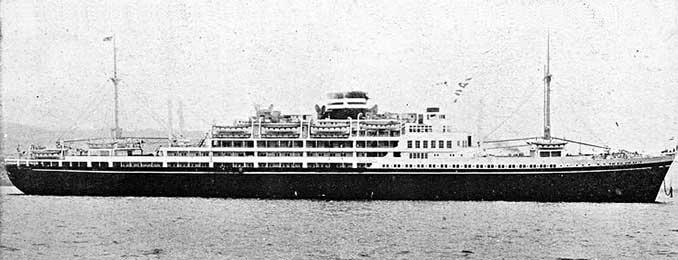
In 1939, its newbuild ships Argentina Maru (あるぜんちな丸) and Brazil Maru (ぶらじる丸) were well-received luxury ocean liners for South America. Both ships were later lost in World War II, but their names were retained on newer ships after the war.
After the war from the mid-1950s, MOL restarted ocean liner routes to South America with the newbuild Brazil Maru and luxury liner Argentina Maru. Japanese emigrants traveled in third class while the ship sailed via Honolulu, San Francisco, Los Angeles, Panama Canal, and the Caribbean before they reached Rio de Janeiro and Buenos Aires. First class and second class cabins were occupied mostly by foreigners and people going to America. They enjoyed the luxury ship.
In 1963, O.S.K. Lines established Japan Emigrant Ship Co. (Nihon Iju-sen K.K. 日本移住船株式会社) to operate emigrant ships to South America. It received the O.S.K. passenger ships which were previously used on the routes. The company was renamed Mitsui O.S.K. Passenger Line (MOPAS) in 1970.
However, Japanese emigrants going to South America dwindled, and the company discontinued its South American routes in 1972. It sold off three of its ocean liners and kept only the Argentina Maru (built in 1958) which was converted into the first Nippon Maru cruise ship in 1972. Nippon Maru was so named by a youth club of Japanese ship fans and it stuck.
MOPAS thereby became one of the world’s first luxury cruise companies in 1972. It offered leisure cruises going around Japan and to Asia such as to Hong Kong and Manila.
In 1973, this first Nippon Maru became Japan’s first cruise ship (not counting ocean liners) to cruise around the world. This world cruise even carried the last Japanese emigrants going to South America by ship.
The first Nippon Maru served only from 1972 to 1976 before being retired and scrapped due to old age. The second Nippon Maru was originally an old Brazilian passenger ship named Rosa da Fonseca (built in 1962) and first served MOPAS as Seven Seas from 1975 to 1977. After the first Nippon Maru was retired, Seven Seas was renamed Nippon Maru and sailed from 1977 to 1990.
MOPAS also bought a used Shin-Sakura Maru in 1981 and converted it into a passenger ship for chartered training seminar cruises.
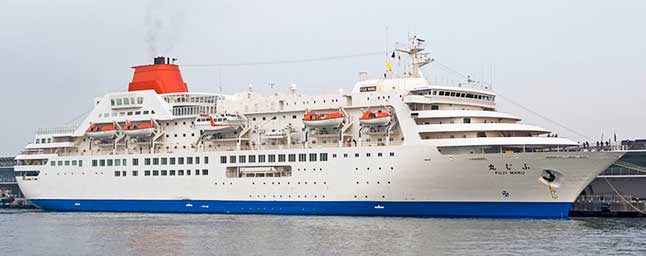
In 1986, recognizing the increasing popularity of leisure cruises, MOPAS decided to build a new cruise ship, the Fuji Maru (ふじ丸) which first sailed in 1989. Built by Mitsubishi Heavy Industries in Kobe, the ship had a gross tonnage of 23,340 and length of 167 meters.
It was Japan’s largest cruise ship at the time and about the same size as the current Nippon Maru. It included a large communal bath with ocean views, an amenity now standard on all Japanese cruise ships. The media called 1989 as Japan’s dawn of luxury cruising. It also coincided with the new Heisei Era.
A year later in 1990, MOPAS launched another new ship, the third-generation and current Nippon Maru to replace the second Nippon Maru. The second Nippon Maru was retired and sold off.
The new Nippon Maru cruise ship had the honor of being christened by Emperor Akihito’s daughter, Princess Sayako, in March 1990.
Maybe it’s a tradition for an Imperial family member to christen any ship named “Nippon Maru” because her parents, then Crown Prince Akihito and Crown Princess Michiko, christened the new Nippon Maru (日本丸) sailing ship in 1984. They used a silver ax to cut the rope tethered to the ship which then rolled into the water.
Princess Sayako is no longer a princess since she married a commoner. She currently serves as the Supreme Priestess of Ise Jingu Shrines, Japan’s most important Shinto shrine, dedicated to the Sun Goddess. (The name “Nippon” is also closely associated with the sun.)
In 2002, Fuji Maru was given to affiliate company Japan Charter Cruises Co. for charter cruises including Ship for World Youth cruises organized by the Cabinet Office. It was retired in July 2013 and sold. Japan Charter Cruises Co. was eventually dissolved.
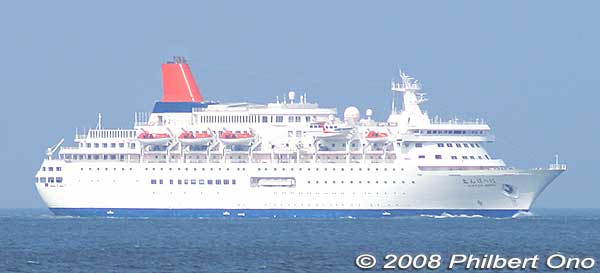
The current Nippon Maru has undergone major and minor refurbishing a number of times during the past 20 years. The ship originally had no balcony cabins until balconies were installed on upper class cabins in 2009. The trademark big, round windows on the top deck were also installed in 2009. The hull was also painted dark blue, making it instantly recognizable in Japan.
The last major refurbishment was in spring 2020, taking 50 days. A few more suites and crew cabins were added besides new interior furnishings. Even after 30+ years, Nippon Maru still looks spic and span for passengers.
Nippon Maru was the first Japanese cruise ship to restart cruising after the pandemic hit. On October 25, 2020, it quietly departed Niihama Port (Ehime Prefecture) for Sasebo Port in Nagasaki with no more than 200 passengers. Returned to Niihama two days later. The other two Japanese cruise ships also soon restarted, but all three ships were later forced to lay idle at port a few times for prolonged periods until spring 2022 when waves of COVID-19 kept hitting Japan.
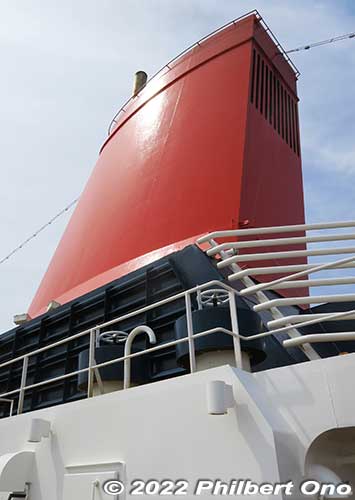
Update: Nippon Maru restarts international cruising in late 2022.
On Dec, 15, 2022, Nippon Maru departed Yokohama on its first overseas cruise since the start of the pandemic. It became the first Japanese cruise ship to sail overseas after the Japanese government allowed international cruises again on Nov. 15, 2022. It went on the 48-day “Mauritius Precious Cruise” to Singapore, Mauritius, and Madagascar. A major sendoff ceremony complete with a live band and flag-waving fans was held at Yokohama Port’s Osanbashi Dock to see off the 200+ passengers. Even Yusuke Ueno, president of Mitsui O.S.K. Passenger Lines, was there to give a celebratory speech.
However, after leaving Madagascar on Jan. 12, three crew members tested positive for COVID-19 and the ship returned to Mauritius on Jan. 14, 2023 to drop them off for medical care. It did not affect the cruise itinerary. The overseas cruise ended safely with the ship returning to Japan as scheduled on January 31, 2023.
Update: Mitsui O.S.K. Lines ordering two new cruise ships.
Being over 30 years old, Nippon Maru is quite old for a cruise ship. So it was welcome news when Mitsui O.S.K. Lines (MOL) announced on Nov. 25, 2022 that it had decided to build two new cruise ships at 35,000 gross tons each. Maximum capacity will be 600 passengers (double occupancy) and 320 crew. Compared to the current Nippon Maru, the new ships will have slightly more space per passenger and slightly more crew per passenger.
Total investment will be about ¥100 billion, and the first ship is to be completed in 2027. However, the shipyard is yet to be determined. The completion date of the second ship is also yet to be determined. Both ships will be flagged under Japan and operated by Mitsui O.S.K. Passenger Lines (MOPAS). No word yet about what will happen to the old Nippon Maru and whether a new ship will be named “Nippon Maru.”
| Nippon Maru (cruise ship) にっぽん丸 | Planned newbuilds (unnamed) | |
|---|---|---|
| Built | 1990 by Mitsubishi Heavy Industries, Kobe, Japan | 2027 / TBD |
| Capacity* | 449 pax, 230 crew | 600 pax, 320 crew |
| Passenger cabins* | 199 | TBD |
| Wheelchair cabins | 2 twin-bed cabins | TBD |
| Length / Width | 166.65 m / 24 m | TBD |
| Draught | 6.6 m | TBD |
| Decks | 7 | TBD |
| Gross tonnage | 22,472 | 35,000 |
| Home port | Tokyo | Tokyo |
| Operator | Mitsui O.S.K. Passenger Lines (MOPAS) | Mitsui O.S.K. Passenger Lines (MOPAS) |
| Parent company | Mitsui O.S.K. Lines (MOL) | Mitsui O.S.K. Lines (MOL) |
| Refurbished | 2010, 2020 | — |
| Remarks | Not to be confused with the Nippon Maru sailing ships. | Two newbuild ships planned. |
| Website | nipponmaru.jp | — |
| Current location | Map | — |
About the name Nippon Maru

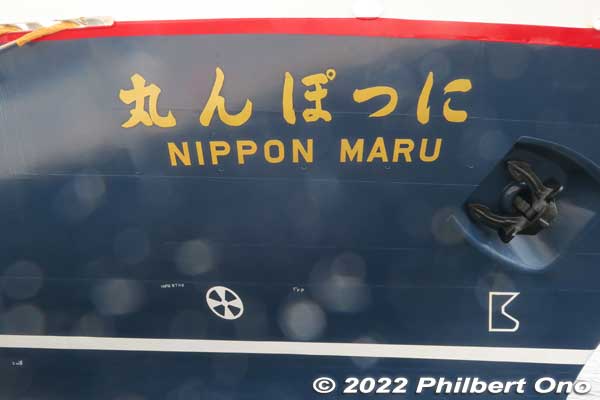
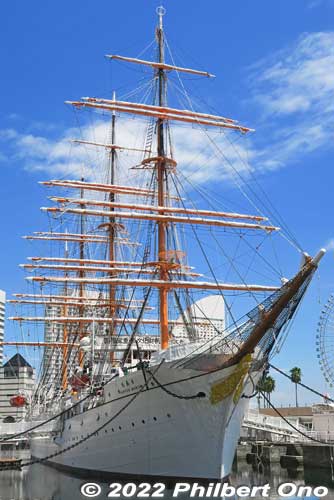
“Nippon Maru” is one of the most famous Japanese ship names because “Nippon” means “Japan.” It’s very symbolic of Japan, similar to “Queen Elizabeth” in the UK.
A number of ships have been named “Nippon Maru” in the past, but the most famous one is the Nippon Maru (日本丸) sailing ship built in 1930. For over 50 years, she sailed around the world to train Japanese sailors and spread goodwill as well, especially in places with a large Japanese community.
In 1984, the original Nippon Maru was succeeded by a new Nippon Maru sailing ship still in service. The old ship then became a museum ship in Yokohama. Sister ship Kaiwo Maru is also a museum ship in Toyama Port.
The successors to both ships continue to join in special maritime celebrations such as the 100th anniversary of Nagoya Port’s opening in 2007. Their presence makes events more festive and more people get to see the sailing ships.
Reference
Official website: nipponmaru.jp
Nippon Maru PR video (10-min.): https://youtu.be/FPEZMknyCac
YouTube channel: https://www.youtube.com/user/nipponmarucruise/videos
Facebook (Japanese): https://www.facebook.com/nipponmarucruise
Nippon Maru official online shop (Amazon): https://www.amazon.co.jp/stores/node/6769115051
Also see: Pacific Venus or Asuka II
Content Navigator
- Ship comparison
- Japanese cruise ship advantages
- COVID-19 protocols
- Basic cruise rules
- Safety Record
- FAQ
- Asuka II
- Nippon Maru (Current page)
- Pacific Venus
Ports for Cruise Ships in Japan
- Cruise ship departure ports
- Japan’s popular ports of call
- Shore excursions
- Mega-ships and harbor bridges
- Japanese port history
- Port town songs
- Major Japanese Ports: Yokohama | Tokyo | Kobe | Hakodate | Nagoya | Kanazawa | Toyama | Amami-Oshima Naze | Yakushima Miyanoura
State of Japanese Cruise Industry in mid-2022
- COVID-19 not over yet
- International cruise ships in Japan
- Japan still closed to international cruising
- Essential Japanese Vocabulary

